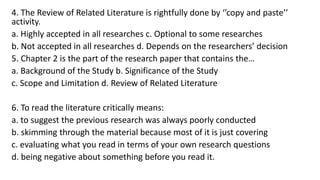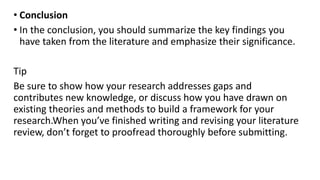RRL.pptx
- 1. What I Know
- 2. Choose the best answer from the choices given. 1. Examining or studying again concepts or ideas related to your research is a. Meta-analysis b. Significance c. Review of Related Literature d. Methodology 2. This referencing style is mostly used in social sciences a. APA b. MLA c. MPA d. Brownian 3. It is in this part where you display the identities or names of all writers or owners of ideas that you incorporated in your research paper. a. definition of terms b. references c. in-text citation d. contents
- 3. 4. The Review of Related Literature is rightfully done by ‘’copy and paste’’ activity. a. Highly accepted in all researches c. Optional to some researches b. Not accepted in all researches d. Depends on the researchers’ decision 5. Chapter 2 is the part of the research paper that contains the… a. Background of the Study b. Significance of the Study c. Scope and Limitation d. Review of Related Literature 6. To read the literature critically means: a. to suggest the previous research was always poorly conducted b. skimming through the material because most of it is just covering c. evaluating what you read in terms of your own research questions d. being negative about something before you read it.
- 4. What I Know? 7. It entails taking a phrase - either spoken or written - and restating it. a. In-text citation b. paraphrasing c. referencing d. synonym 8. Plagiarism is an act of a. stealing and passing off intellectual properties as one's own b. using someone else’s work without crediting the source c. presenting as original and novel an idea or invention copied from an existing source d. all of the above 9. Which choice reveals what should not be included in the bibliography? a. Age of the author b. Author’s name c.Titles of the article d. The dates of the article 10. Which of the following does not provide credibility and value to your study? a. Falsifying documents b. Integrity b. Confidentiality agreement d. Privacy and disclosure contract
- 5. ANSWER
- 6. •Literature is an oral or written record of man’s significant experiences that are expressed in an ordinary manner. • It is conveyed directly or indirectly. Direct expressions is in books, journals, periodic papers, and online reading materials. Indirect expressions are not written or spoken at all but is mirror image of his environment (Ridley 2012). • The Review of Related Literature is one of the main components of a research study, specifically in the second chapter • It gives an overview of all the writings relative to a specific topic (Prieto, Naval & Carey, 2017).
- 7. • A review of related literature is the process of collecting, selecting, and reading books, journals, reports, abstracts, and other reference materials • The following information may be collected: 1. Background knowledge about the problem and associated ideas. 2. Theories that give details of the presence of the problem and certain variables that is connected to the problem. 3. Data that prove the occurrence and gravity of the problem 4. Detailed and broad results of related studies 5. Gaps and recommendations for additional study specified in related studies
- 8. • The significance and rationale of related literature and studies is to find out the similarities and differences between the past and present studies, to get ideas into the critical and controversial aspects of the problem. • It helps recognize and define a research problem. It gives the researcher a background analysis aspect, which have been studied. • It guides the researcher on what to do on the mechanism of the research methods; this also provides the thoughts to advance with the study until its conclusion. • It avoids redundant duplication of a study. Moreover, reading extensively will enrich your background knowledge on your research topic that will enable you to establish a good groundwork or course of your research endeavor.
- 9. How to write Review of Related Literature Step 1 – Search for relevant literature • Before you begin searching for literature, you need a clearly defined topic. • If you are writing the literature review section of a dissertation or research paper, you will search for literature related to your research problem and questions. Literature review research question example What is the impact of social media on body image among Generation Z?
- 10. • Make a list of keywords • Start by creating a list of keywords related to your research question. Include each of the key concepts or variables you’re interested in, and list any synonyms and related terms. You can add to this list as you discover new keywords in the process of your literature search. • Keywords Example Social media, Facebook, Instagram, Twitter, Snapchat, TikTok Body image, self-perception, self-esteem, mental health Generation Z, teenagers, adolescents, youth • Search for relevant sources • Use your keywords to begin searching for sources.
- 11. Make sure to read the abstract to find out whether an article is relevant to your question. When you find a useful book or article, you can check the bibliography to find other relevant sources. • Step 2 – Evaluate and select sources • You likely won’t be able to read absolutely everything that has been written on your topic, so it will be necessary to evaluate which sources are most relevant to your research question.
- 12. For each publication, ask yourself: What question or problem is the author addressing? What are the key concepts and how are they defined? What are the key theories, models, and methods? Does the research use established frameworks or take an innovative approach? What are the results and conclusions of the study? How does the publication relate to other literature in the field? Does it confirm, add to, or challenge established knowledge? What are the strengths and weaknesses of the research? Make sure the sources you use are credible, and make sure you read any landmark studies and major theories in your field of research.
- 13. • Take notes and cite your sources • As you read, you should also begin the writing process. Take notes that you can later incorporate into the text of your literature review. • It is important to keep track of your sources with citations to avoid plagiarism. It can be helpful to make an annotated bibliography, where you compile full citation information and write a paragraph of summary and analysis for each source. This helps you remember what you read and saves time later in the process.
- 14. In reviewing related literature, you come up with ideas borrowed from someone else; therefore, it is but polite, honesty, and courtesy to learn to acknowledge other people’s intellectual rights and to avoid plagiarism. The following are three terms to express recognition of author’s ownership of borrowed ideas (Sharp, 2012). 1. Acknowledgment. It identifies individuals who have contributed to the making of the manuscript, written at the start of the paper.
- 15. • Step 3 – Identify themes, debates, and gaps • To begin organizing your literature review’s argument and structure, be sure you understand the connections and relationships between the sources you’ve read. Based on your reading and notes, you can look for: • Trends and patterns (in theory, method or results): do certain approaches become more or less popular over time? • Themes: what questions or concepts recur across the literature? • Debates, conflicts and contradictions: where do sources disagree? • Pivotal publications: are there any influential theories or studies that changed the direction of the field? • Gaps: what is missing from the literature? Are there weaknesses that need to be addressed?
- 16. • Example of trends and gapsIn reviewing the literature on social media and body image, you note that: • Most research has focused on young women. • There is an increasing interest in the visual aspects of social media. • But there is still a lack of robust research on highly visual platforms like Instagram and Snapchat—this is a gap that you could address in your own research.
- 17. • Step 4 – Outline your literature review’s structure • There are various approaches to organizing the body of a literature review. Depending on the length of your literature review, you can combine several of these strategies (for example, your overall structure might be thematic, but each theme is discussed chronologically).
- 18. • Chronological • The simplest approach is to trace the development of the topic over time. However, if you choose this strategy, be careful to avoid simply listing and summarizing sources in order. • Try to analyze patterns, turning points and key debates that have shaped the direction of the field. Give your interpretation of how and why certain developments occurred.
- 19. • Thematic • If you have found some recurring central themes, you can organize your literature review into subsections that address different aspects of the topic. • For example, if you are reviewing literature about inequalities in migrant health outcomes, key themes might include healthcare policy, language barriers, cultural attitudes, legal status, and economic access.
- 20. • Methodological • If you draw your sources from different disciplines or fields that use a variety of research methods, you might want to compare the results and conclusions that emerge from different approaches. For example: • Look at what results have emerged in qualitative versus quantitative research • Discuss how the topic has been approached by empirical versus theoretical scholarship • Divide the literature into sociological, historical, and cultural sources
- 21. • Theoretical • A literature review is often the foundation for a theoretical framework. You can use it to discuss various theories, models, and definitions of key concepts. • You might argue for the relevance of a specific theoretical approach, or combine various theoretical concepts to create a framework for your research.
- 22. • Step 5 – Write your literature review Like any other academic text, your literature review should have an introduction, a main body, and a conclusion. What you include in each depends on the objective of your literature review. Introduction The introduction should clearly establish the focus and purpose of the literature review. Tip If you are writing the literature review as part of your dissertation or thesis, reiterate your central problem or research question and give a brief summary of the scholarly context. You can emphasize the timeliness of the topic (“many recent studies have focused on the problem of x”) or highlight a gap in the literature (“while there has been much research on x, few researchers have taken y into consideration”).
- 23. • Body Depending on the length of your literature review, you might want to divide the body into subsections. You can use a subheading for each theme, time period, or methodological approach. As you write, you can follow these tips: Summarize and synthesize: give an overview of the main points of each source and combine them into a coherent whole Analyze and interpret: don’t just paraphrase other researchers—add your own interpretations where possible, discussing the significance of findings in relation to the literature as a whole Critically evaluate: mention the strengths and weaknesses of your sources Write in well-structured paragraphs: use transition words and topic sentences to draw connections, comparisons and contrasts
- 24. • Conclusion • In the conclusion, you should summarize the key findings you have taken from the literature and emphasize their significance. Tip Be sure to show how your research addresses gaps and contributes new knowledge, or discuss how you have drawn on existing theories and methods to build a framework for your research.When you’ve finished writing and revising your literature review, don’t forget to proofread thoroughly before submitting.























